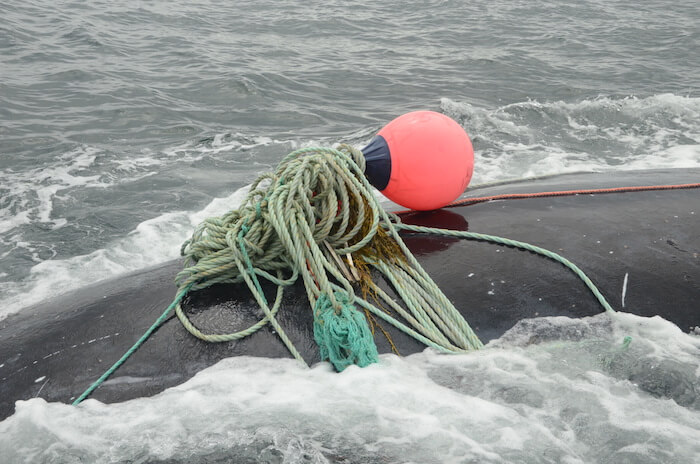July 13, 2018, 14:45, off the coast of New Brunswick’s Miscou Island, an aerial survey conducted by the National Oceanic and Atmospheric Administration (NOAA) observes a right whale dragging a rope 4 times the length of its own body. The Marine Animal Response Society (MARS) is quickly notified of the situation. NOAA was able to provide several details on how exactly the whale was entangled. These valuable details allow the response teams not only to establish an appropriate action plan, but also to have key information to identify the animal in the event it is resighted.
The main difficulty in this type of incident is that we are dealing with a wild animal that is mobile and stressed and whose behaviour can be unpredictable. Finding an entangled whale after an initial sighting can also prove to be quite challenging. Despite the joint efforts of Fisheries and Oceans Canada and NOAA, the right whale has not been relocated since July 13.
However, right whales are still being seen in many fisheries. Fisheries and Oceans Canada is announcing new closures of fishing areas. The measure will be applied beginning July 20 and will remain in force until further notice.
Back to the Kleenex case
On April 12 off the coast of Miscou Island, members of the Center for Coastal Studies observed Kleenex, a right whale that has been entangled for three years now. This case illustrates the difficulty of tracking whales that have gotten themselves entangled but are still swimming freely. Some of the rope was cut in an attempt to untangle the animal, after which it disappeared. It was reseen twice during the month of June and on July 12 by the Northeast Fisheries Science Center’s aerial team. Based on these observations, the animal was described as showing deteriorating health, while its state of entanglement had not changed since the most recent release attempt in April.
Observation networks are encouraged to keep an eye on this case and document any changes observed in Kleenex’s state of entanglement or health status.
From entanglements to unfortunate consequences
Due to their feeding habits and their physiology, right whales are particularly prone to entanglements. Studies show that more than 80% of the population bears traces of entanglement. Dragging fishing gear can compromise the whale’s ability to swim and feed, leading to a significant increase in energy expenditure or even to starvation. Moreover, depending on how severe the entanglement is, the physiological and behavioural stress suffered by the whale can impair its immune system and thus make it more vulnerable to the development of chronic infections.
As in the case of Kleenex, entanglements can cause an increase in the presence of cyamids – also known as whale lice – on the animal’s skin. These crustaceans will generally lodge themselves on the skin in areas of low water flow, especially where the animal has sustained injury. Because this phenomenon is more pronounced when whales are unable to maintain optimum swimming speeds following entanglements, cyamid levels can be used to provide an indication of a whale’s health status.
Learn more
Right Whales: The Situation in 2018(Whales Online, 2018)
Right Whale Mortalities 2017: Overview (Whales Online, 2017)
Right Whales: An Entangled Whale Named Kleenex (Whales Online, 2018)
Entangled Whales: A Complex Situation (Whales Online, 2018)
(2011) Cassoff, R.M., K.M. Moore, W.A. McLelland, S.G. Barco, D.S. Rotstein, M.J. Moore. Lethal entanglement in baleen whales. Diseases of Aquatic Organisms. 96: 175-185.
(2004) Pettis, H.M., R.M. Rolland, P.K. Hamilton, S. Brault, A.R. Knowlton, S.D. Kraus. Visual health assessment of North Atlantic right whales (Eubalaena glacialis) using photographs. Canadian Journal of Zoology. 82: 8-19.






